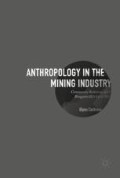Abstract
Former Papua New Guinea (PNG) Prime Minister Somare said that Rio Tinto had been complicit in the conduct of the war, a charge the company denied. In 1988 Francis Ona resigned his job at the mine and formed the Bougainville Revolutionary Army (BRA), and Sam Kauona, Ona’s right-hand man, broke into the mine’s magazine, stole dynamite and blew up electricity pylons, and shot at and wounded Australians, leading to a closure of the mine in 1990. In dismissing allegations that mine owner Rio Tinto was responsible, Cochrane says that the way the Australian colonial administration acquired land for the mine and disposed of its wealth plus the fact that Bougainville considered itself to be part of the Solomon Islands rather than PNG were contributing factors.
The chapter on Bougainville draws on my time in what was then Western District in the British Solomon Islands Protectorate (BSIP) where as an Administrative Officer I met with my Australian counterparts from PNG from time to time; experiences as a World Bank Advisor resident in Port Moresby in the 1980s; contact and conversations with Douglas Oliver, whom I got to know in the 1960s when he sent his graduate student Roger Keesing to do research on Malaita where I was working in the Solomon Islands; Hugh Laracy in Auckland who is especially knowledgeable about the Catholic Marist missionaries; and Gene Ogan whom I met in Bougainville and in Honolulu.
Access this chapter
Tax calculation will be finalised at checkout
Purchases are for personal use only
Bibliography
Angrosino, Michael V., ed. 1976. Do Applied Anthropologists Apply Anthropology? Athens: University of Georgia Press.
Bellamy, John. 1979. The Tudor Law of Treason. London: Routledge.
Belshaw, Cyril. 1976. The Sorcerer’s Apprentice: An Anthropology of Public Policy. New York: Pergamon.
Brokensha, David. 1966. Applied Anthropology in English-Speaking Africa. Ithaca, NY: Society for Applied Anthropology, Monograph 8.
Brosius, Peter J. 1999. Analysis and Interventions: Anthropological Engagement with Environmentalism. Current Anthropology 40(3): 277–310.
Cochrane, Glynn. 1970. Big Men and Cargo Cults. Oxford: Oxford University Press.
———. 1974. Land Alienation: The Case for Traditionalists. Oceania 45(2): 124–131.
Denoon, Donald. 2000. Getting Under the Skin: The Bougainville Copper Agreement and the Creation of the Panguna Mine. Melbourne: Melbourne University Press.
Dreger, Alice. 2011. Darkness’s Descent on the American Anthropological Association: A Cautionary Tale. Human Nature 22: 225–246.
Epstein, A.L. 1969. Matupit, Land, Politics and Change Among the Tolai of New Britain. Berkeley: University of California Press.
Filer, Colin. 1990. The Bougainville Rebellion, The Mining Industry and the Process of Social Disintegration in Papua New Guinea. Canberra Anthropology 13(1): 1–39.
Forster, George M. 1969. Applied Anthropology. Boston: Little Brown.
Grillo, Ralph, and Alan Rew, eds. 1985. Social Anthropology and Development Policy. ASA Monograph No. 23. London: Tavistock Publications.
Hage, Per. 2004. East Papuan Kinship Systems: Bougainville. Oceania 75(2): 109–124.
Hoben, Alan. 1982. Anthropologists and Development. Annual Review of Anthropology 11: 349–375.
Jackson, Richard. 1991. Not Without Influence: Villagers, Mining Companies and Governments in Papua New Guinea. In Mining and Indigenous Peoples in Australasia, ed. J. Connell and R. Howitt. Sydney: Sydney University Press.
Jorgenson, Dan. 1997. Who and What is a Landowner? Mythology and Marking the Ground in a Papua New Guinea Mining Project. Anthropological Forum 7(4): 599–627.
Keesing, Roger. 1989. Creating the Past: Custom and Identity in the Contemporary Pacific. Honolulu: University of Hawaii Press.
Kirsch, Stuart. 2015. Reverse Anthropology: Indigenous Analysis of Social and Environmental Relations in New Guinea. Palo Alto, CA: Stanford University Press.
Laracy, Hugh. 1976. Marists and Melanesians; A History of the Catholic Missions in the Solomon Islands. Honolulu: University Press of Hawaii.
Lasslett, Kristian. 2009. Winning Hearts and Mines: The Bougainville Crisis, 1988–90. London: Routledge.
May, R.J., and M. Spriggs, eds. 1990. The Bougainville Crisis. Bathurst: Crawford House Press.
Nash, J. (1974). Matriliny and Modernisation: The Nagovisi of South Bougainville. New Guinea Research Bulletin No. 55, Port Moresby and Canberra, Australian National University, pp. 63–64.
Ogan, Eugene. 1971. Nasioi Land Tenure: An Extended Case Study. Oceania XLII(2): 81–93.
———. 1991. The Cultural Background to the Bougainville Crisis. Journal de la Société des Océanistes 92(1): 61–67.
———. 1996. Copra Came Before Copper: The Nasioi of Bougainville and Plantation Agriculture 1902–1964. Pacific Studies 19:31–52.
———. 1999. The Bougainville Conflict: Perspectives from Nasioi. Technical Report Discussion Paper, Australian National University, 99/3.
Oliver, Douglas. 1955. A Solomon Island Society: The Siwai of Bougainville. Cambridge: Harvard University Press.
———. 1991. Black Islanders, A Personal Perspective of Bougainville 1937–1991. Honolulu: University of Hawaii Press.
Palomka, Peter, ed. 1990. Bougainville: Perspectives on a Crisis. Canberra Papers on Strategy and Defence, vol. 66.
Simpson, S. Rowton. 1976. Land, Law and Registration. Cambridge: Cambridge University Press.
Skalnik, Peter. 1989. Lihir Society on the Eve of Mining Operations: A Long Term Project for Urgent Anthropological Research in Papua New Guinea. Bulletin of the International Committee on Urgent Anthropological Research, Nos. 32–33. Vienna: UNESCO.
West, Richard. 1972. River of Tears: The Rise of the Rio Tinto Zinc Corporation Limited. London: Earth Island.
Worsley, Peter. 1964. The Trumpet Shall Sound. London: Methuen.
Author information
Authors and Affiliations
Rights and permissions
Copyright information
© 2017 The Author(s)
About this chapter
Cite this chapter
Cochrane, G. (2017). Bougainville Lessons for Rio Tinto. In: Anthropology in the Mining Industry. Palgrave Macmillan, Cham. https://doi.org/10.1007/978-3-319-50310-3_2
Download citation
DOI: https://doi.org/10.1007/978-3-319-50310-3_2
Published:
Publisher Name: Palgrave Macmillan, Cham
Print ISBN: 978-3-319-50309-7
Online ISBN: 978-3-319-50310-3
eBook Packages: Social SciencesSocial Sciences (R0)

